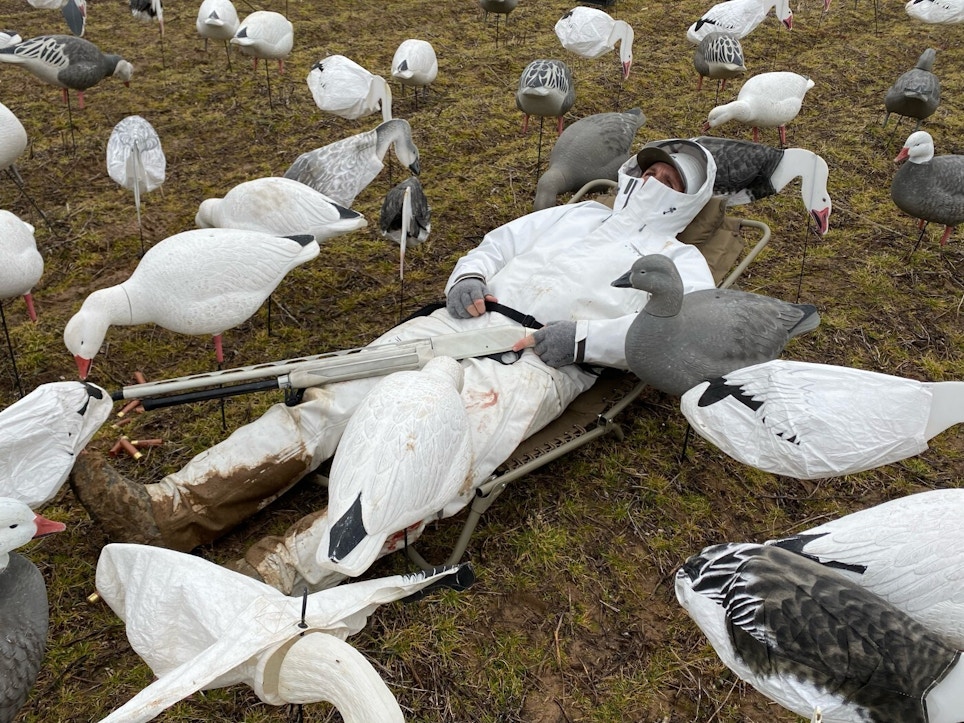Snow goose hunters are a special group within the waterfowl world. They’re decked out in white, instead of camo, and are usually in a field instead of on water. They can use electronic calls and unplugged shotguns and often have hundreds or thousands of decoys. Snow goose hunters are next-level diehards who need tough, reliable gear.
Once traditional waterfowl season ends in January, most hunters put away their gear with a sigh of relief tinged with wistfulness. Others are champing at the bit to get going for the light goose season to open. That’s technically what snow geese are called, along with blue and Ross’ geese. Similar to Canada geese, the snow goose has a Greater and Lesser variety. Blue and Ross’ geese are considered cool bonus birds, far outnumbered by the snows. The special spring Light Goose Conservation Order has been in place since 1999. It was established as a way to try to reduce numbers of the migratory birds that annually decimate thousands of acres on Canada breeding grounds and along the Atlantic, Mississippi and Central flyways.
Light goose regulations are relaxed from those in traditional waterfowl seasons. They include:
— Allowance of unplugged shotguns
— Allowance of electronic calls
— Shooting time extended 30 minutes past sunset
— No bag limit
— Only a valid hunting license from any state; some states require a free permit for data
If you’re in one of the major flyways, chances are good you’re encountering duck hunters from late summer through January. Months before the season opens, many hunters with bucket-list trips on their minds are eyeing Canada and the Upper Midwest states’ early opening days. A few might even have in mind Alaska for harlequins or the northeast coast in Maine, Massachusetts and New Hampshire for sea ducks. They’re getting ready early, stocking up on ammo.
As the season rolls on in autumn and early winter, snow goose hunters are getting their gear and plans ready for spring. They, too, may have bucket-list trips on the calendar: Texas, Louisiana, Arkansas, Missouri, Oklahoma, Kansas, Maryland. They’ll be scoping out electronic calls, stocking up on ammo — lots of it — and making sure their gear will be ready for a workout. Remember, unplugged guns mean a lot of shooting.
Not every waterfowler will chase snows. It takes a special desire to get up earlier than normal and put out 1,000 or more rags, decoys, shells and an electronic flyer or two, and then make sure everyone is positioned correctly and properly camouflaged (in white, remember) and is aware of the safety routines and shooting lanes. And then you call in — if they cooperate — flocks of wary, eagle-eyed snow geese. Many hunters will book trips with guides, not unlike regular waterfowling, and help out with some of that process — because that’s usually part of the hunt — while not having to buy everything.
Still, anyone hunting snow geese in spring will need gear. Here’s what you can sell them.
Boots, Apparel
Last spring I hunted for a couple of days in central Arkansas with Kendall and Keaton Kelso, who own KK Outfitters in southeast Kansas. Natives of Iowa, they grew up outdoors hunting and fishing everything from small game and deer to waterfowl. When the light goose conservation seasons were established in 1999, they began pursuing snow geese harder along the Mississippi Flyway.
At our goose camp, we were outfitted in white pull-over pants and zip-up tops, along with a white toque. It wasn’t cold enough for us to worry about bulking up, which was nice. All we had to do was chill out on our reclining chairs when the geese were circling and not flash our moonbeam faces at the birds. Our boots were dark, which wasn’t a worry because they blended with the unplowed field the geese wanted to land in near the decoys.
Solid white from head to toe isn’t required. Your customers don’t need to look like the Michelin Man or Mr. Stay-Puft, but they will need white pants and tops, or a white jumpsuit, and maybe a white cap or beanie. Gloves, maybe, if they want them. We had some inexpensive, gray fingerless gloves that worked like a champ.
We weren’t sweating, but we weren’t cold, either, which is how spring hunting goes. February and March can be weird, though. Insulated and uninsulated knee boots are great for mucky agriculture fields and the occasional ditch to cross. Be sure to ask customers if they have or need boots, along with socks for warm to cold conditions. I donned some thin Swiftwick wool socks in my DryShod boots and was fit as a fiddle.
Ammunition
Loading 10 rounds of 3- and 3 1/2-inch magnum goose-blasters into a shotgun magazine was a different experience. In 45 years of chasing waterfowl, I’d never put in more than three. We ran the mags dry a couple of times, and then sat amazed that six of us had fired almost 60 rounds in one volley. And then we reloaded in case any birds wheeled back over.
With the allowance of unplugged guns, this may be your biggest selling point to spring snow goose hunters. They will shoot a lot if the birds are there and come into the decoys. They will shoot more than they expect or probably ever have. If they run out of ammo, it won’t be fun trying to find more, especially if they’re in a rural area and have to visit one or more “marts” looking for anything.
Consider adding an extra case or three of 3 1/2- and 3-inch shells to your shelves for spring. Better yet, create a snow goose display with all the goods: shells, white apparel, boots. Ammo will be a hot seller for goose hunters, whether they’re going after them in spring or they want to stock up for the next season.
And speaking of unplugged shotguns, since most factory shotguns only hold five shells, many snowgoose hunters will want to add an extended magazine tube to their gun. Stocking some aftermarket options for the most popular shotgun models might be a smart bet.
Calls, Bags
Electronic callers are legal for the spring season, which opens the door for sales that also could reach into other seasons for predators. Don’t overlook these great possibilities when you can offer and suggest products for multi-season hunting.
The Snow Pro caller from FoxPro, for example, has 37 snow goose sounds, 29 predator sounds, and nine crow calls. It’s available in white, which helps it hide, and it cranks up the volume on quiet mornings when hunters need to get the attention of geese, predators or crows. Winter and spring are great times for all three hunting situations. The Snow Pro handles up to 300 sounds, has long cords to its 10-watt speakers so hunters can move them around in decoy spreads, works with a remote control and is built for the worst weather conditions.
Another great seller, which crosses multiple seasons, is an accessory bag. Hunters take so much stuff into the field. Calls, snacks, containers of coffee or soup for cold days, extra ammunition, repair kits for waders or guns — the list can be long. Some hunters are minimalists and take little, while others prepare like they’re going to invade a small country. Good, tough and reliable game bags can help either kind of hunter.
Backpacks are a good sales option. Many today are designed with waterproof or weather-proof materials, durable zippers and ample room with myriad pockets. Open space in the backpack holds ammo boxes, a Thermos, clothes and other gear. They’re easy to shoulder and cover multiple seasons. The backpack doesn’t have to be white, either, for snow goose hunters. A camo backpack or bag will blend in just fine.
Blind bags offer an added benefit thanks to their design. Many today are built like tool bags you see in big-box stores: hearty, wide zippers easy to grasp in cold temps or with gloves, a wide-mouth opening to see and retrieve or store miscellaneous items, and multiple pockets inside and out to put more gear. Hunting blind bags today also typically have waterproof, molded rubber bottoms that keep out moisture and mud. Simply spray off and be done.
These backpacks or bags can be used, too, in other seasons. I have both, and they’re set up for deer and waterfowl. With just a few additions and takeaways, I could have either of them ready for a trip for turkeys, upland birds or small game. The blind bag works for fishing, too. Multi-purpose gear always is a great selling point.
Don’t overlook the chance to sell to hunters during snow goose season. Whether they’re diehards with a trailer full of rags and decoys or travelers going with guides, they will need some gear you can sell. Stock a few well-planned items, have an eye-catching display and be ready.






